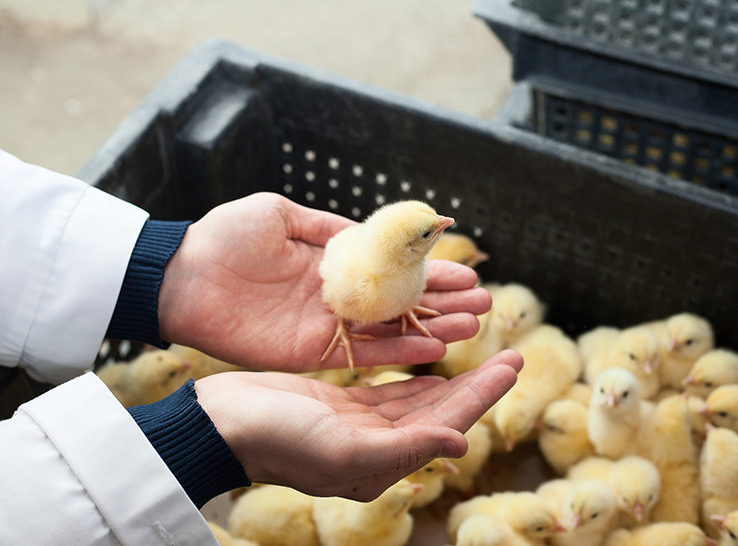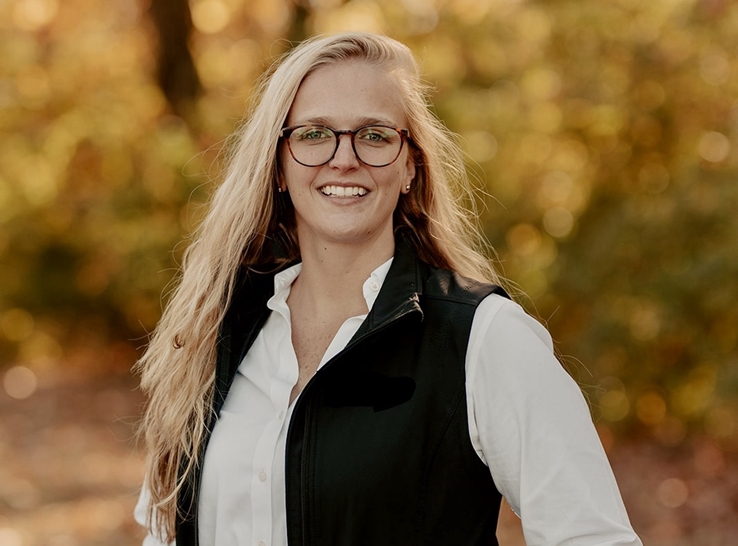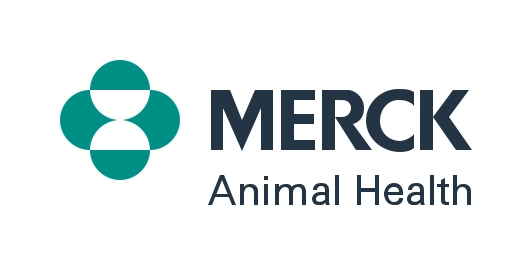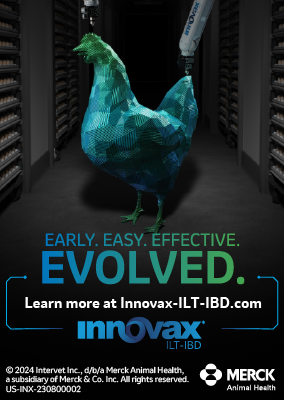She might not have a background in poultry farming, but Emily Kimminau, PhD, has firmly become one of the industry’s go-to specialists in coccidiosis — a disease that remains one of the most prevalent and costly challenges in global poultry production.
With a PhD in poultry science and a career that has spanned technical roles across pharmaceuticals, nutrition and product development, she now supports customers implementing Merck Animal Health’s vaccine programs across the US poultry industry.
In the following Q&A, she talks about disease trends, gut health strategies and what the future holds for data-driven poultry production.
You didn’t grow up in agriculture — what brought you to poultry health and your current role at Merck Animal Health?
I’m originally from Williamsburg, Virginia, and I had no idea what the agriculture industry was. I worked as a historical interpreter in Colonial Williamsburg, which is a little different from chickens. When I went to college, I met some animal science majors and was fascinated by what they were studying. That led me to add it as a major and eventually start working on poultry research at Virginia Tech.
From there, I went on to do a master’s and PhD focused on coccidiosis and necrotic enteritis. I essentially cold-emailed the authors of the coccidia chapter in Diseases of Poultry, and one of them connected me with a lab in Georgia. I’ve never looked back, and I’ve been working with coccidia ever since — it’s a niche but an important problem, and it’s certainly not going away anytime soon.
Since I graduated, I’ve worked across the industry, in vaccine support, product development and drug portfolios, and I joined Merck Animal Health in August 2024. Now, I support our coccidial vaccine in the field and help ensure it’s applied effectively and consistently.
What does your day-to-day look like in this role?
My role is a mix of fieldwork and technical support. I’m out checking vaccine application and cycling, troubleshooting issues and helping producers solve problems so they can produce the best chickens with the least amount of coccidiosis issues.
I also contribute to Merck Animal Health’s research, whether that’s evaluating new products or collecting data to support existing ones. It’s a good balance between science and hands-on problem solving.
What’s the current picture with coccidiosis pressure in the field?
In the US, the last decade saw a shift to antibiotic-free production, which meant fewer producers were using ionophores. Some have started to reintroduce them, but many are turning to alternative options to grow healthy chickens without drugs, and one of those is a coccidial vaccine.
What’s positive is that producers are getting more strategic — they’re mixing tools like a coccidial vaccine, feed additives and rotation programs more effectively than they did 10 years ago.
They understand we don’t have an endless supply of drugs, so extending the efficacy of existing in- feed options is critical.
But it’s not just coccidiosis. We’re also seeing increased pressure from viral and bacterial pathogens like avian influenza, which makes minimizing the things we can control, like coccidiosis, even more important.
Are you seeing producers adapt their control strategies?
Definitely. Rotation programs are more sophisticated now, especially as producers recognize how quickly resistance builds to chemical anticoccidials. Coccidial vaccines help here by seeding drug-sensitive strains back into the house, which improves sensitivity and makes the drugs more effective when reused.
I’m also seeing more producers use combinations of alternatives — saponins, essential oils and probiotics — to create custom programs that support bird health throughout the cycle.
How do you help producers assess whether their programs are actually working?
We still use post-mortem lesion scoring, which is a quick way to develop a snapshot of what coccidiosis looks like at the complex, but we’re combining that with other tools like oocyst counts (OPGs), environmental observations and management checks. It’s about building a full picture — what’s in the bird, what’s in the house and how performance is trending over time.
OPGs alone aren’t perfect, but if you look at cycling patterns — for example, a spike, then drop in oocyst levels — it helps indicate if immunity is developing. It’s important because producers don’t get paid based on oocyst counts; they get paid for bird performance and survivability.
Looking at gut health more broadly, how central is it to everything else?
Minimizing gut health problems is crucial. As birds get more efficient at feed conversion, their guts are under more pressure, and even small disruptions can have a big effect on growth. Stress can open up tight junctions and lead to bacterial issues like E. coli or Clostridium.
So gut health isn’t just about preventing coccidiosis — it impacts everything from performance to food safety. Antibiotics aren’t the only answer, and we need to find combinations that work long-term without burning out the few tools we have left.
What other disease and welfare trends are you keeping an eye on?
Viral issues are a growing concern. We’re seeing reactions to viruses last longer and appear outside of traditional seasonal windows, which adds another layer of challenge. On the bacterial side, removing hatchery antibiotics has brought increased Clostridium, E. coli and Enterococcus pressure in some systems.
There’s also growing scrutiny around food safety and consumer expectations. Coccidiosis control ties into that — if gut integrity is poor, you’re more likely to see food safety pathogens downstream.
You mentioned research — what areas have you been involved in so far in your current role?
I’ve contributed to evaluating new product candidates and supporting our current vaccine through field studies. One exciting area is anticoccidial sensitivity testing — looking at how field strains respond to different drugs and tracking changes over time. It helps producers see the impact of vaccine use on restoring sensitivity and helps us build better programs.
Merck Animal Health is also putting a lot of emphasis on developing new technology and new products, which is really encouraging for the long term.
What opportunities and challenges do you see ahead for the poultry industry?
So much of it comes back to data, and I think we’re on the verge of a new era in how we use it. We’re collecting huge amounts of information, and now the focus is shifting to how we interpret and apply it. With better tools for metadata analysis, we’ll start spotting meaningful trends and refining programs faster and more precisely than before. That’s really exciting, because it’s something that will help us overcome the other challenges we’re facing.
On sustainability, poultry often gets left out of the conversation compared to cattle or swine. But we’re arguably one of the most efficient systems — better feed conversion, less land use and shorter life cycles. There’s room to improve, but we’ve already come a long way.
If you could see one thing change on-farm, what would it be?
A greater focus on placement day. That early window — getting temperatures, feed and water right — has a massive downstream impact. Less stress means better yolk absorption, stronger immunity, better vaccine uptake and ultimately, better performance. Producers can’t put 100% of their energy into everything, but focusing on that early stage of life is really important.
Editor’s note: Content on Modern Poultry’s Industry Insights pages is provided and/or commissioned by our sponsors, who assume full responsibility for its accuracy and compliance.






